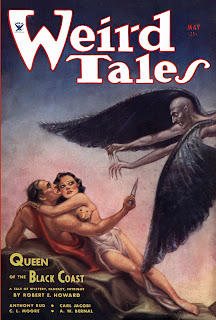Robert E. Howard’s short story “Queen of the Black Coast”
introduced Conan’s first love, Bêlit, a passionate, ruthless pirate queen full
of “the urge of creation and the urge of death” (128). Her name comes from the
same storehouse of Canaanite/Assyrian legends that brought deities like Ishtar
and Derketo into Howard’s Hyborian Age fiction. In real-life legend, Bêlit belonged
to the same pantheon, often associated with Ishtar and Derketo, although it’s
hard now to know whether the goddesses were popularly connected at the time of
their active worship, or whether the association happened when the sources were
later compiled out of varied lore.
In either case, Howard’s
Bêlit namechecks two goddesses with whom her namesake was syncretized (Ishtar
and Derketo), and also mentions Bel, who was her counterpart’s father in some
legends and her husband in others, saying, “Above all are the gods of the
Shemites – Ishtar and Ashtoreth and Derketo and Adonis. Bel, too, is
Shemitish…” (Howard 247).
The following
tidbits are taken from The Story of
Assyria, by Zénaïde Ragozin, known to
have been one of Howard’s sources:
“As to the female deity of the Canaanites, ASHTORETH (whom the
Greeks have called ASTARTE), she is the ISHTAR and MYLITTA and BÊLIT
(“BAALATH,” “Lady,”) of the Assyro-Babylonian cycle of gods, scarcely changed
either in name or nature; the goddess both of love and war, of incessant
production and laborious motherhood, and of voluptuous, idle enjoyment , the
greatest difference being that Ashtoreth is identified with the moon and wears
the sign of the crescent, while the Babylonian goddess rules he planet Venus,
the Morning and Evening Star of the poets” (107 – 108).
“The planet Venus appearing in the
evening, soon after sunset, and then again in the early morning, just before
dawn, it was called Ishtar at night and Bêlit at dawn, as a small tablet
expressly informs us; a distinction which, apparently confusing, rather tends
to confirm the fundamental identity between the two, -- Ishtar, ‘the goddess,’
and Bêlit, ‘the lady’” (19).
“In ASCALON, where the goddess was worshipped under the name
DERKETO, she was represented under the form of a woman ending, from the hips,
in the body of a fish” (111). This is of particular interest to Howard readers,
since we know that Bêlit’s “fathers were kings of
Askalon!” (Howard 243).
Ragozin also states, “To the
Canaanites, the Sun and Moon – the masculine and feminine principles, as
represented by the elements of fire and moisture, the great Father and Mother
of beings – were husband and wife. … in Ascalon and the other cities of the
Philistine confederation they both assumed the peculiarity noted above,
together with other names, and became, she, the fish-goddess Derketo, and he,
the fish-god Dagon (from dag, fish,
in the Semitic languages)” (114).
Of course,
Derketo is mentioned as a goddess in Howard’s stories; Dagon is well-known, especially
from the work of H.P. Lovecraft, but also appearing, connected with Derketo, in
Howard’s story “The Servants of Bit-Yakin.”






